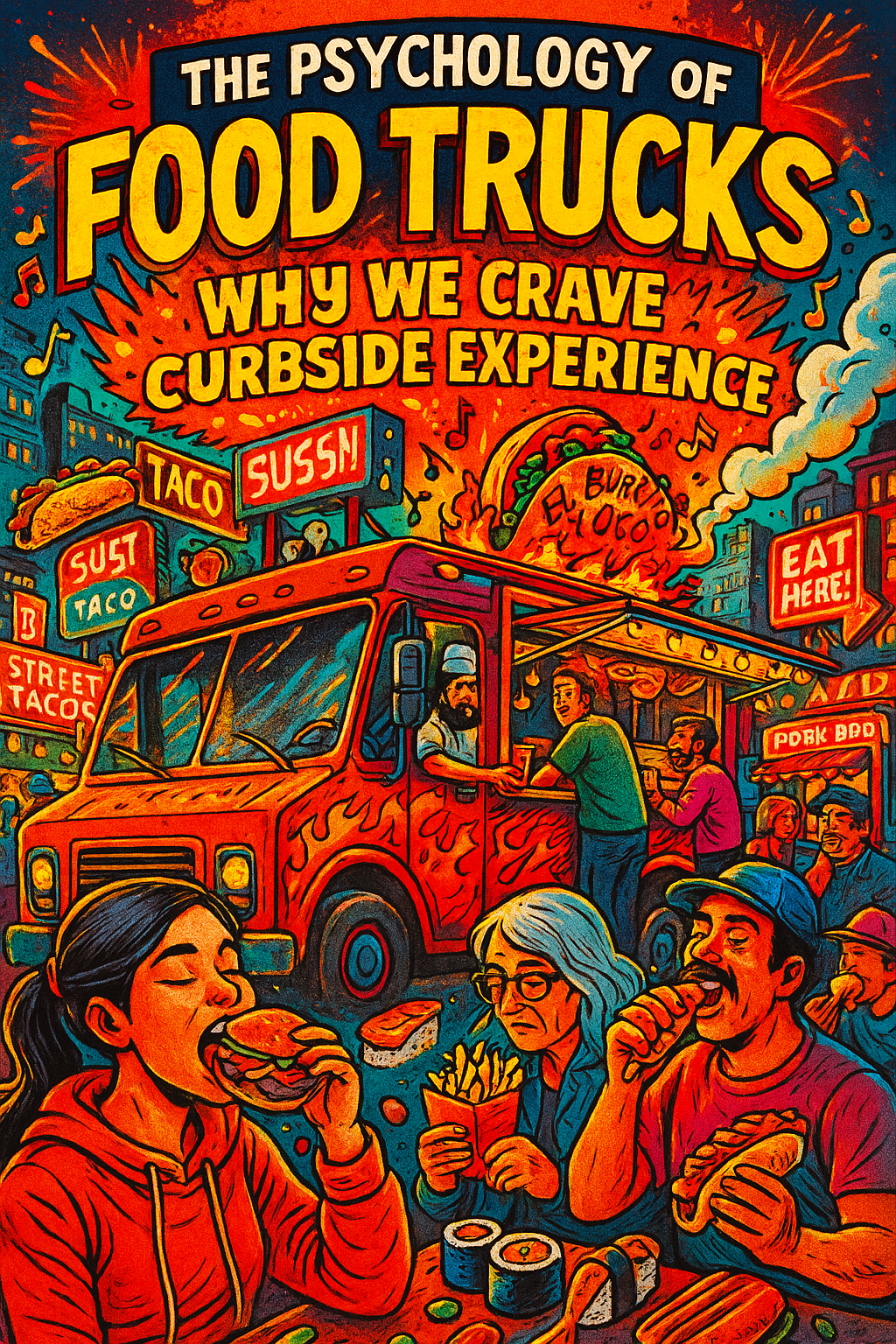
Curbside Taste
HOW URBAN PSYCHOLOGY SHAPES FOOD TRUCK CULTURE
WHY WE CRAVE THE CURBSIDE EXPERIENCE
Food trucks are more than mobile kitchens—they are emotional ecosystems embedded in urban life. Their appeal stems from psychological triggers that go beyond taste or convenience. They offer immediacy, autonomy, and sensory immersion in ways static restaurants cannot. The rise of food trucks reflects a shift in how people seek connection, novelty, and identity through everyday rituals.
These vehicles of flavor are also vehicles of meaning, tapping into primal instincts and modern urban rhythms. From visual stimulation to social signaling, food trucks engage multiple layers of human behavior. Their popularity is not accidental—it’s rooted in behavioral design and emotional resonance. This article explores the psychological architecture behind food truck culture, decoding why curbside dining feels intimate, exciting, and authentic. Each section unpacks a distinct emotional driver, revealing how food trucks satisfy deeper human needs. The goal is clarity, not hype—just facts, mapped to feeling.
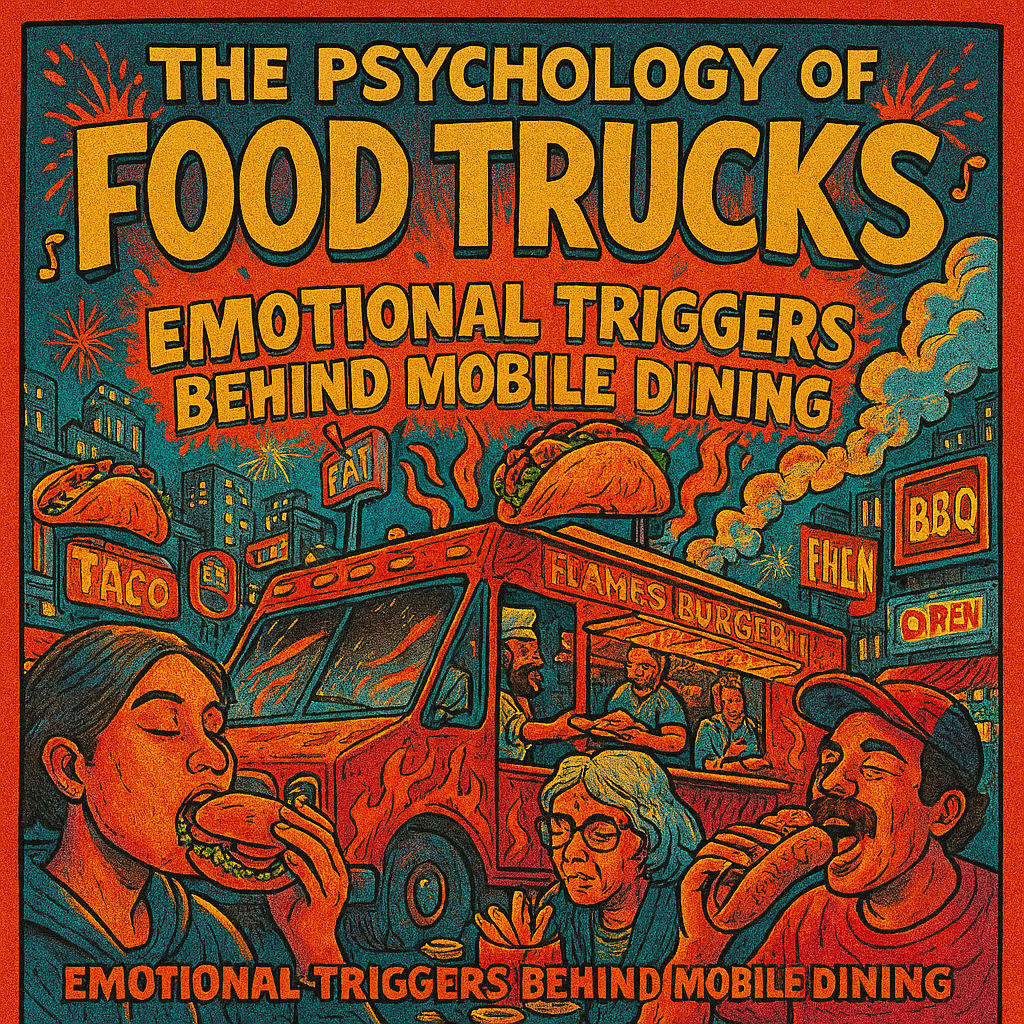
The Food Truck Psychology
SENSORY IMMERSION AND STREET-LEVEL ENGAGEMENT
Food trucks activate a full spectrum of sensory engagement, starting with scent. The open-air setting allows aromas to diffuse freely, triggering appetite through olfactory stimulation. Visual cues like bold graphics, sizzling griddles, and colorful plating stimulate dopamine release. Customers hear the rhythmic clatter of utensils and the hum of urban life, enhancing the perception of freshness. Unlike enclosed restaurants, food trucks offer unfiltered sensory access that feels raw and immediate.
This immersion increases emotional arousal and makes meals feel more memorable. The absence of walls fosters openness—both physically and socially—encouraging spontaneous interaction. People associate food trucks with vitality, movement, and freedom. The sensory richness of the curbside setting is a key reason why food trucks feel more alive than static eateries. They are not just places to eat—they are places to feel.
SCARCITY AND THE EXCITEMENT OF LIMITED ACCESS
Food trucks often operate on rotating schedules or pop-up formats, creating urgency. This scarcity effect heightens emotional investment and makes the food feel more special. When something is not always available, it becomes more desirable. Customers are drawn to the idea of catching a truck before it moves on, turning a meal into a moment. Limited access creates psychological tension that enhances satisfaction when fulfilled. The unpredictability of location and timing adds an element of adventure.
People enjoy the thrill of discovering a truck in an unexpected spot, reinforcing the pleasure of novelty. Scarcity also fosters loyalty—customers track schedules and follow social media updates to stay informed. This behavior reflects deeper psychological patterns tied to reward anticipation. Food trucks thrive on this dynamic, transforming availability into emotional currency.
NOSTALGIA AND THE MEMORY OF SIMPLER TIMES
Food trucks often evoke memories of childhood, street fairs, and family outings. Their design and atmosphere tap into nostalgic emotions that make experiences feel warmer. The simplicity of ordering from a window and eating on the curb reminds people of carefree moments. Nostalgia is a powerful emotional driver—it deepens attachment and enhances satisfaction. Many trucks use retro aesthetics or comfort foods to trigger these feelings. Customers are not just eating—they are revisiting emotional memories.
This connection between food and memory amplifies the psychological impact of the experience. Nostalgia also fosters storytelling—people share food truck moments as part of their personal narrative. The emotional warmth of these memories builds brand loyalty and repeat visits. Food trucks become edible time machines, transporting people to places they’ve loved.
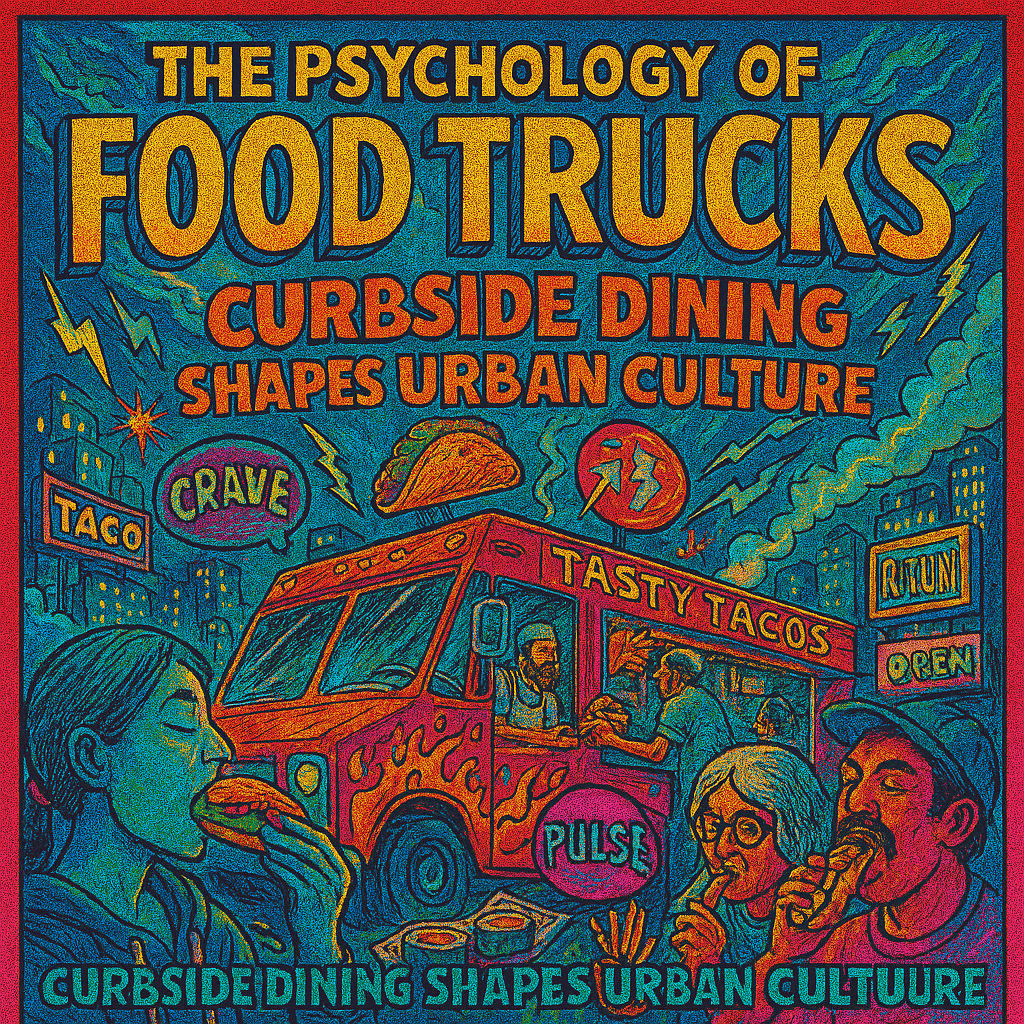
AUTONOMY AND THE FREEDOM TO CHOOSE
Food trucks offer a sense of control that traditional dining often lacks. Customers decide where to eat, when to eat, and how to engage. There are no reservations, dress codes, or formalities—just choice. This autonomy appeals to people who value flexibility and independence. The ability to walk up, order, and leave creates a feeling of empowerment. Food trucks support spontaneous decisions and personal agency. This freedom enhances emotional satisfaction and reduces stress. Autonomy is a core psychological need, and food trucks fulfill it with every transaction. Customers feel like participants, not just consumers. Dining becomes a self-directed experience, reinforcing the pleasure of choice.
SOCIAL SIGNALING AND IDENTITY EXPRESSION
Eating at a food truck is often a form of social signaling. It communicates openness to new experiences, support for local businesses, and alignment with urban culture. People use food choices to express identity, and food trucks offer a platform for that expression. Whether it’s vegan fusion or Korean barbecue, the selection reflects personal values. Customers feel seen and validated by their choices.
Sharing food truck photos on social media reinforces this signaling, turning meals into messages. The act of choosing a food truck becomes part of a personal brand. This behavior is rooted in the psychology of self-presentation. Food trucks become mirrors of self-image, reflecting who we are and what we value. They are not just places to eat—they are places to be seen.
COMMUNITY AND MICRO-INTERACTIONS
Food trucks foster spontaneous social encounters that static restaurants rarely replicate. People chat in line, share recommendations, and bond over shared discoveries. These micro-interactions build a sense of community and emotional warmth. The casual setting lowers social barriers, encouraging openness and connection. Food trucks often cluster in parks or markets, creating communal zones. This spatial intimacy enhances the feeling of belonging. Customers feel part of something larger, even if only for a moment. The shared experience of curbside dining becomes a social ritual. These interactions contribute to emotional well-being and urban cohesion. Food trucks become hubs of togetherness, not just commerce.
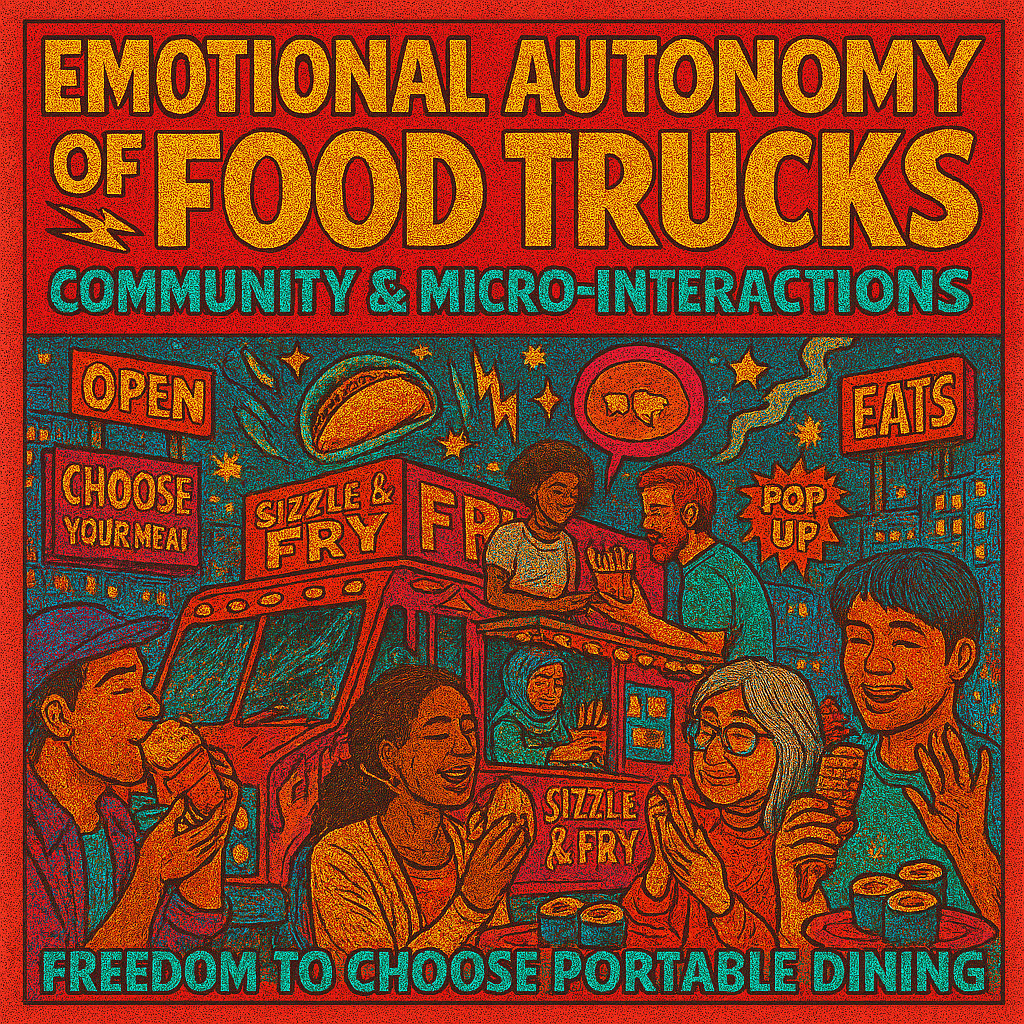
NOVELTY AND THE PLEASURE OF DISCOVERY
Humans are wired to seek novelty, and food trucks deliver it in bite-sized bursts. New menus, changing locations, and creative branding keep the experience fresh. Customers enjoy the unpredictability and the sense of adventure. Each visit feels like a small discovery, stimulating curiosity and engagement. Novelty breaks routine and adds excitement to daily life. Food trucks thrive on this dynamic, constantly evolving to surprise and delight. They are mobile laboratories of flavor and design. Discovery becomes part of the meal, enhancing emotional satisfaction. This behavior reflects the brain’s reward system, which responds strongly to new stimuli. Food trucks are not just meals—they are explorations.
SYMBOLISM AND THE AESTHETICS OF REBELLION
Food trucks often symbolize rebellion against corporate dining. Their aesthetics are raw, colorful, and expressive, challenging polished uniformity. Customers are drawn to this authenticity and creative resistance. The truck itself becomes a canvas for storytelling—graffiti, hand-painted signs, and quirky names signal independence. This symbolism resonates with people seeking alternatives to mainstream culture. Food trucks represent culinary counterculture, offering flavor with attitude. The design is part of the message, reinforcing emotional connection. Customers feel like insiders, part of a movement. This aesthetic rebellion enhances brand loyalty and emotional engagement. Food trucks are not just businesses—they are statements.
FLEXIBILITY AND ADAPTIVE URBANISM
Food trucks adapt to urban rhythms with remarkable agility. They move with the crowd, respond to events, and shift with demand. This flexibility mirrors modern lifestyles and urban fluidity. Customers appreciate the responsiveness and relevance. Food trucks meet people where they are, filling gaps in the city’s foodscape. Their mobility reflects the dynamic nature of urban living. This adaptability enhances emotional resonance and practical value. Food trucks are not fixed—they evolve with the city. They are urban chameleons, blending into festivals, markets, and neighborhoods. Their presence reflects the pulse of the street.
TRUST AND TRANSPARENCY IN PREPARATION
Customers often trust food trucks more than hidden kitchens. The cooking process is visible and immediate, reducing uncertainty. There’s no mystery behind the scenes—just open preparation. This transparency builds confidence and emotional comfort. People see the ingredients, the hygiene, and the care. It feels honest and direct, reinforcing trust. Trust is a key emotional factor in food choices, and food trucks offer it in real time. The open kitchen becomes a stage, inviting observation and engagement. Customers feel connected to the process, not just the product. Food trucks deliver culinary truth without curtains.
RITUAL AND THE POWER OF REPETITION
Regular visits to a favorite food truck become ritual. People form habits around location, timing, and menu. These rituals provide comfort, structure, and emotional grounding. They anchor moments in the week, turning transactions into traditions. Ritual enhances emotional attachment and deepens satisfaction. Customers feel connected through repetition, reinforcing loyalty. Food trucks become part of personal rhythm and urban routine. They are edible rituals, woven into daily life. The repetition adds meaning and emotional depth. Food trucks are not just meals—they are moments that matter.
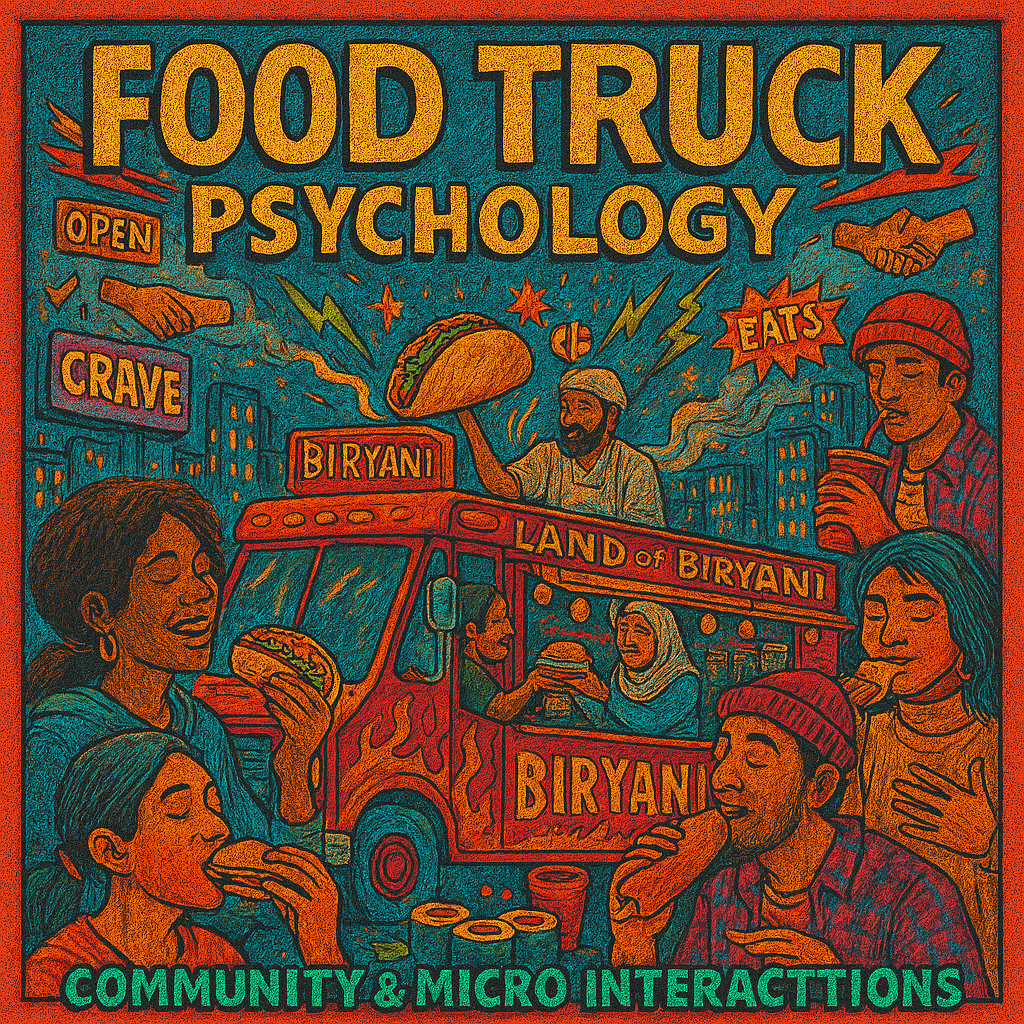
PLAYFULNESS AND THE JOY OF INFORMALITY
Food trucks invite play through design, menu, and atmosphere. Their names, themes, and setups are often whimsical and lighthearted. This playfulness reduces pressure and encourages experimentation. Customers feel relaxed, open, and curious. The informality fosters emotional ease and spontaneity. People try new things without fear of judgment. The setting feels like a playground for adults, blending flavor with fun. Play is essential to emotional well-being, and food trucks deliver it with style. They are joyful spaces that celebrate creativity. Food trucks turn dining into delight.
CONCLUSION
Food trucks are psychological ecosystems that reflect how people live, feel, and connect. Their success is rooted in emotional resonance, not just culinary skill. From autonomy to nostalgia, each layer adds depth to the experience. Food trucks meet emotional needs in ways static restaurants often cannot.
They offer immediacy, flexibility, and symbolic richness. Their mobility mirrors urban rhythms, while their aesthetics challenge conformity. Customers are drawn not just to the food, but to the feeling. Food trucks transform dining into ritual, identity, and play. They are not trends—they are emotional infrastructure. Understanding their psychology reveals why they thrive and why they endure.
JOIN THE DISCUSSION
Which emotional layer of food trucks resonates most with you? Do you crave the spontaneity, the sensory immersion, or the symbolic rebellion? Have you ever followed a truck across the city just to relive a memory or reclaim a moment?
#FoodTruckPsychology #CurbsideCulture #EmotionalDining #UrbanRituals #SensoryStreetEats #MobileMealsMatter #NostalgiaOnWheels #IdentityThroughFood #PopUpEmotion #CulinaryFreedom #StreetFoodSymbolism #TrustTheTruck #PlayfulPalates #CommunityCuisine #RitualOnTheRoad





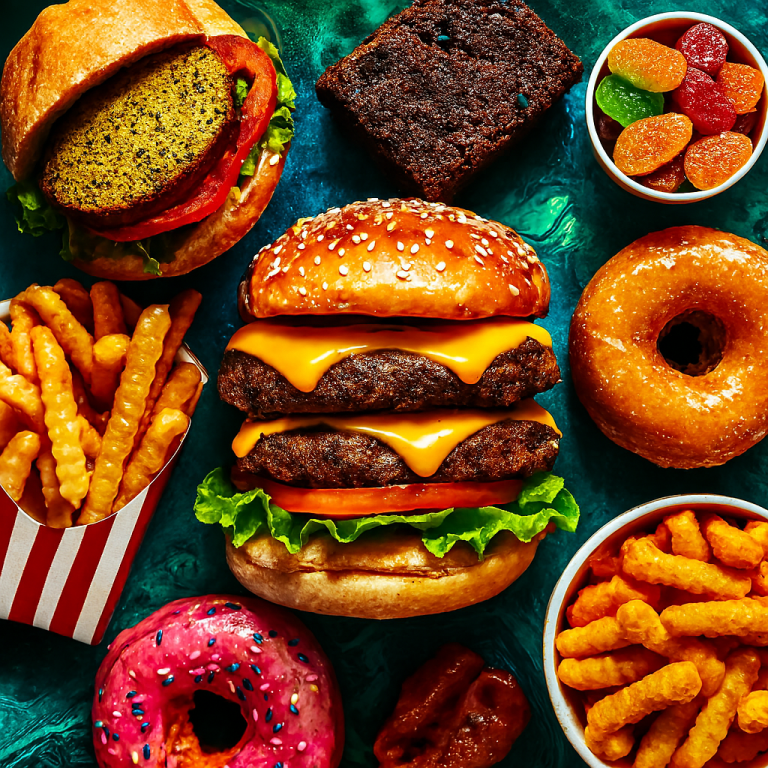

1 thought on “FOOD TRUCK PSYCHOLOGY OF AMAZING TASTE 365 DAYS A YEAR”